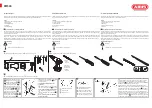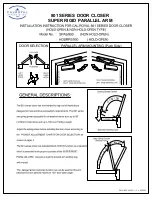
Manuale di Installazione Uso e Manutenzione - Installation, Use and
Maintenance Manual
pag. 31
In caso di problematiche, l'utente può tentare di risolvere l’anomalia.
Prima di contattare l’azienda fornitrice, seguire le indicazioni della tabella
seguente.
User can use the unit after trial operation. Before contacting us, you can
make self trouble shooting following below chart in case of any failure.
19 - LOCALIZZAZIONE DEI GUASTI
19- BREAKDOWN DIAGNOSTIC
SINTOMI
SYMPTOMS
POSSIBILI CAUSE
POSSIBLE CAUSE
Le ventole non funzionano:
Fans doesn't work:
Mancata alimentazione elettrica.
Missing power supply
.
Gli interruttori del termostato non sono nella giusta posizione di funzionamento.
The switches of the thermostat are not in the right position of working.
Ci sono corpi estranei che bloccano i rotori
.
There are foreign bodies that block the rotors.
Cablaggi elettrici da verificare
.
Check electrical connections
.
Motore fuori dall' assorbimento:
Motor out of the absorption:
La pressione è inferiore a quella prevista e quindi il flusso d'aria è eccessivo.
Pression is low than what is required and then the air flow is excessive.
Aumentare le perdite di carico con serrande di taratura.
It must increase pressure drops with calibration dampers.
Eccessiva densità del fluido. Velocità di rotazione troppo alta.
Excessive density of the fluid. Rotation speed too high.
Flusso d' aria eccessivo:
Excessive air flow:
Il calo di pressione del sistema è sovrastimato.
Pressure drop of the system are overvalued.
Flusso d'aria insufficiente:
Insufficient air flow:
La caduta di pressione del sistema é maggiore del previsto.
Pressure drop of the system are underestimated.
Intasamenti dei condotti d'aria.
Cloggings in the air ducts.
Velocità di rotazione troppo bassa: verificare il collegamento che sia corretto nella morsettiera e che la tensione
corrisponda a quella della targhetta.
Rotation speed too low: verify on the terminal board of the motor that the connection is correct and that
the voltage correspond to that of the nameplate
.
La girante ruota al contrario.
The rotor turn backwards.
Rumore:
Noise:
Flusso d'aria eccessivo.
Excessive air flow.
Trafilamenti d'aria dai giunti dei canali per mancata sigillatura o fessurazioni
.
Air leakage from the duct joints.
Ventola sbilanciata.
Unbalanced fan.
Corpi estranei all'interno.
Foreign bodies in the case.
Forti vibrazioni:
Strong vibrations:
Girante sbilanciata a causa di usura o di deposito di polvere.
Unbalanced impeller because of wear or of dust deposit.
Spostamento della girante a causa di deformazioni dei supporti.
Sliding of the impeller on the case due to deformations.
Intasamenti nei condotti dell'aria.
Cloggings in the air ducts.
20 - SMALTIMENTO
20 - DISMANTLING
Al termine del loro utilizzo le unità saranno smaltite, nel rispetto delle
norme vigenti.
In particolare la direttiva Europea 2012/19/UE sui rifiuti di apparecchiatu-
re elettriche ed elettroniche, prescrive lo smaltimento dei rifiuti al di fuori
del normale flusso di rifiuti. I materiali delle unità smontate devono esse-
re prelevati separatamente per ottimizzare il riciclaggio dei materiali che
li costituiscono ed evitare possibili danni per la salute e l’ambiente.
I materiali che compongono le unità sono:
Lamiera zincata.
EPS (polistirolo espanso).
Polietilene.
Plastica ABS (acrilonitrile butadiene stirene).
NBR (gomma nitrile butadiene NBR).
At the end of their use the units will be disposed of,in observance of the
norms in force.
In particular, the European Directive 2012/19/UE about the electric and
electronic equipments wastes, prescribes the waste disposal outside the
normal waste flow. The materials of the dismantled units have to be
separately picked up to optimise the recycling of the materials that con-
stitute them and prevent possible damages for health and environment.
The materials that compose the units are:
Galvanized plate.
EPS (expanded polystyrene).
Polyethylene.
ABS plastic (acrylonitrile butadiene styrene).
NBR (nitrile butadiene rubber NBR).
Summary of Contents for HACI-RP 25
Page 32: ......




































